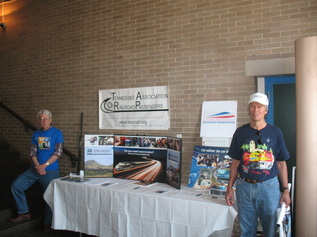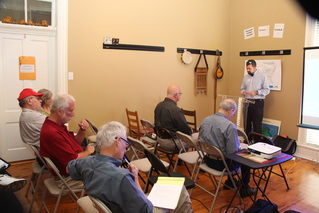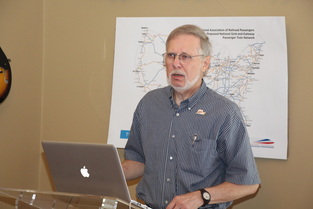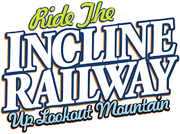A voice for passenger rail in Tennessee!
|
Quick Facts
|
Our Story
A most unfortunate episode in the history of passenger rail led a group of concerned Tennesseans to form an organization dedicated to the restoration and expansion of passenger rail service in the Volunteer State.
In 1979, Amtrak - the National Railroad Passenger Corporation - was given a change in marching orders from the Carter Administration and was forced to eliminate a number of long-distance passenger routes across the system.
One of the most critical losses was Amtrak's Floridian, a Chicago to Florida service descended from some of the most celebrated trains in the South, particularly the beloved Dixie Flyer of the famed Louisville & Nashville Railroad.
Through the better part of its short history, the Floridian struggled to earn its identity as a train worth riding. Though it served a market with incredible potential, a combination of poor track conditions, a notoriously unreliable scheduled, and issues with equipment interfered with the train's ability to attract riders, and a series of derailments did nothing to help matters either.
As the decade of the 70's drew to a close, however, the Floridian began to find higher ground. The train was finally settled in to a more reliable route, most of the equipment ills had been remedied, and Amtrak's reputation as a whole was improving. Just as the Floridian started to post substantial ridership growth, the Carter Administration mandated a series of service reductions.
News of the Floridian's demise did not go over well with Tennesseans, even among the large populous that had never before ridden the train. The sad announcement prompted a group of concerned Tennesseans to form the Tennessee Association of Railroad Passengers.
Despite the organization's best efforts, including a public rally attended by Senator Albert Gore, the Floridian made its last call at Nashville Union Station on October 1, 1979. On that day, Music City became - and still remains - one of the largest cities on the American continent without passenger rail service.
Fortunately, not all was lost with the discontinuance of the Floridian. West Tennessee was still being served by the Panama Limited with service from Chicago to New Orleans making nighttime stops in Memphis and Dyersburg. This train, which was later renamed the City of New Orleans, was a service worth fighting to keep, and TARP members turned their attention in that direction.
Amtrak received a fair amount of capital investment in the early 1980's and thence made an enormous investment in new and rebuilt equipment. Several states, including North Carolina, one of Tennessee's neighboring states, sponsored a number of new routes and supplemental services. Though Tennessee was fortunate to still have a train serving the state's largest city, there was still plenty to be desired, and then some.
The Amtrak facility in Memphis was truly a sore spot, not to mention an eye sore. Several publications, including Passenger Train Journal, the Memphis Commercial Appeal, and even TARP's own newsletter described Memphis Central Station as simply the worst train station in the entire country. To add further insult to injury, the City of New Orleans called at inconvenient hours in the middle of the night. Even the most dedicated rail fan would be apprehensive about those conditions, and leaving a car parked overnight at Memphis Central Station was, for lack of a better term, simply unwise.
Dyersburg, Amtrak's other station stop in Tennessee, was really no better than Memphis. The "station" consisted of a small, vandalized shelter in a seedy part of town. A police escort was often required just to ensure the safety of passengers and the security of their vehicles.
With so many limitations, TARP had plenty of work cut out. Convincing Tennesseans to travel by train was difficult, at best. TARP members kept forging ahead with new ideas and grassroots momentum.
TARP actively supported improved stations in Memphis and Dyersburg while also supporting additional train service in West Tennessee. Whenever the annual "Amtrak budget battle" commenced in Washington, TARP members responded with letters and phone calls to Tennessee's delegation. When the river front railroad tracks in Memphis were threatened with removal, TARP responded with a position paper, a letter-writing campaign, and other efforts to help ensure the preservation the historic downtown rail line for future transportation needs. TARP also played a key role in keeping the idea of restoring Chicago to Florida passenger service, especially in time for the 1996 Olympic Games in Atlanta that year.
The river front tracks in Memphis were saved from abandonment, and plans emerged for restoring Memphis Central Station as a mixed-use facility that would help spring further cultural and economic development in the city's historic downtown. Additionally, plans emerged from the drawing board to introduce a downtown trolley to keep downtown Memphis connected and on the move.
In March of 1994, a new era came about for the City of New Orleans. Not only was the train re-equipped with modern Superliner equipment, the train gained higher sleeper car capacity and a full-service dining car for the first time in many years. Alas, Tennessee had a train not only worth preserving, but worth bragging about! As a result, more Tennesseans began to take the train.
Meanwhile, back in Nashville, TARP members were managing to keep the idea of a restored Floridian alive, but another idea of even greater merit was gathering attention. TARP members in cooperation with Nashville city officials, the Metropolitan Transportation Authority, and the Broadway Dinner Train, among other supporters, began a commuter rail experiment to gauge the level of interest in offering area residents a driving alternative. The first experiment was conducted in 1991 with some success, followed by a much more successful experiment in 1992. By 1993, actual platforms were in place and the response from riders made only one conclusion possible - Nashville wants a commuter train!
The middle of the 90's decade was not the best times for Amtrak, which caused a great deal of concern for TARP. At the advice of a multi-million dollar business consulting firm, Amtrak reduced almost all long distance trains to less-than-daily service, and ridership responded accordingly, that is, negatively. TARP's quest to get the Floridian restored got nowhere as the various state governments did not show real enthusiasm, did not want to make financial commitments, and were unlikely to agree on other issues such as scheduling and routing.
All of the gloom and discouragement did make a turn for the better as the decade came to a close. In 1998, Amtrak began operating a daily train from Chicago to Louisville, Kentucky, bringing service closer to Nashville than it had been in decades. The Kentucky Cardinal was somewhat of an aberration as it ran on a lethargic schedule that averaged less than 30 MPH, operated with merely one coach, no food service car, and the occasional sleeper. For all its flaws, the Kentucky Cardinal held a glimmer of hope that Nashville would soon lose its distinction as one of the largest cities in the country without a passenger train.
In the year 2000, another round of progress was being made. The Tennessee Department of Transportation began to focus on the possibilities of renewed rail transportation for both freight and passenger. TARP helped sponsor a Rail Transportation Conference in Nashville that year and provided two people to serve on the Department of Transportation Committee to help establish priorities for rail. Publicity for TARP increased dramatically after the group held a public relations table at the Tennessee State Fair and hosted the Region V annual meeting for the National Association of Railroad Passengers (NARP).
Although Tennessee had, for the moment, turned into a bright spot for rail transportation, the situation at Amtrak turned into a crisis of almost epic proportions. It became clear that Amtrak would not glide into self-sufficiently as promised, and the company's brash initiative to carry freight and express had failed to generate additional capital. By mid-2003, Amtrak was slowly grinding to a halt and was on the verge of total insolvency.
Under Amtrak's new leadership, Mr. David Gunn, the sour situation was temporarily reversed. Congress agreed to fund the railroad, and David Gunn began making major internal reforms to get the railroad back on track focusing on the basics of running a passenger railroad. One of those initiatives was to exit the freight and express business which was draining the company's limited resources. Unfortunately, the Kentucky Cardinal became a casualty of this restructuring simply because its core purpose was not to carry passengers, but to carry freight and express.The Kentucky Cardinal's discontinuance was truly discouraging to TARP members who had anticipated the train being extended to Nashville. Activity within the TARP organization began to diminish as a result. The continuing core group within the TARP organization did, however, remain active and soldiered on to support a brighter future for Amtrak. Of even greater significance, the funding and planning for commuter rail service in Nashville was realized and construction began.
In 2005, it became obvious to the core group of TARP members that the organization has every reason to reactivate, grow, and work even harder to make passenger rail a true priority in Tennessee's transportation initiatives. As part of an organizational restructuring and refocus, TARP's Board of Directors is putting together plans for a year of growth, refocus, and development in 2006. A new website combined with a revamped newsletter, new publicity efforts, and more consistent follow-up with elected leaders are all part of this strategic initiative.
In 2006 our dream of Nashville commuter rail service came true when the Music City Star turned its wheels for the first time. The commuter rail experiment that TARP members supported in the early 1990's came to fruition as a scheduled service. This important development has refueled the organization and encouraged us to continue our fight for passenger rail!
As ridership on the Music City Star grows along with ridership on Amtrak's City of New Orleans, membership in TARP has grown steadily! With any luck we will see passenger rail service take hold across the state!
A most unfortunate episode in the history of passenger rail led a group of concerned Tennesseans to form an organization dedicated to the restoration and expansion of passenger rail service in the Volunteer State.
In 1979, Amtrak - the National Railroad Passenger Corporation - was given a change in marching orders from the Carter Administration and was forced to eliminate a number of long-distance passenger routes across the system.
One of the most critical losses was Amtrak's Floridian, a Chicago to Florida service descended from some of the most celebrated trains in the South, particularly the beloved Dixie Flyer of the famed Louisville & Nashville Railroad.
Through the better part of its short history, the Floridian struggled to earn its identity as a train worth riding. Though it served a market with incredible potential, a combination of poor track conditions, a notoriously unreliable scheduled, and issues with equipment interfered with the train's ability to attract riders, and a series of derailments did nothing to help matters either.
As the decade of the 70's drew to a close, however, the Floridian began to find higher ground. The train was finally settled in to a more reliable route, most of the equipment ills had been remedied, and Amtrak's reputation as a whole was improving. Just as the Floridian started to post substantial ridership growth, the Carter Administration mandated a series of service reductions.
News of the Floridian's demise did not go over well with Tennesseans, even among the large populous that had never before ridden the train. The sad announcement prompted a group of concerned Tennesseans to form the Tennessee Association of Railroad Passengers.
Despite the organization's best efforts, including a public rally attended by Senator Albert Gore, the Floridian made its last call at Nashville Union Station on October 1, 1979. On that day, Music City became - and still remains - one of the largest cities on the American continent without passenger rail service.
Fortunately, not all was lost with the discontinuance of the Floridian. West Tennessee was still being served by the Panama Limited with service from Chicago to New Orleans making nighttime stops in Memphis and Dyersburg. This train, which was later renamed the City of New Orleans, was a service worth fighting to keep, and TARP members turned their attention in that direction.
Amtrak received a fair amount of capital investment in the early 1980's and thence made an enormous investment in new and rebuilt equipment. Several states, including North Carolina, one of Tennessee's neighboring states, sponsored a number of new routes and supplemental services. Though Tennessee was fortunate to still have a train serving the state's largest city, there was still plenty to be desired, and then some.
The Amtrak facility in Memphis was truly a sore spot, not to mention an eye sore. Several publications, including Passenger Train Journal, the Memphis Commercial Appeal, and even TARP's own newsletter described Memphis Central Station as simply the worst train station in the entire country. To add further insult to injury, the City of New Orleans called at inconvenient hours in the middle of the night. Even the most dedicated rail fan would be apprehensive about those conditions, and leaving a car parked overnight at Memphis Central Station was, for lack of a better term, simply unwise.
Dyersburg, Amtrak's other station stop in Tennessee, was really no better than Memphis. The "station" consisted of a small, vandalized shelter in a seedy part of town. A police escort was often required just to ensure the safety of passengers and the security of their vehicles.
With so many limitations, TARP had plenty of work cut out. Convincing Tennesseans to travel by train was difficult, at best. TARP members kept forging ahead with new ideas and grassroots momentum.
TARP actively supported improved stations in Memphis and Dyersburg while also supporting additional train service in West Tennessee. Whenever the annual "Amtrak budget battle" commenced in Washington, TARP members responded with letters and phone calls to Tennessee's delegation. When the river front railroad tracks in Memphis were threatened with removal, TARP responded with a position paper, a letter-writing campaign, and other efforts to help ensure the preservation the historic downtown rail line for future transportation needs. TARP also played a key role in keeping the idea of restoring Chicago to Florida passenger service, especially in time for the 1996 Olympic Games in Atlanta that year.
The river front tracks in Memphis were saved from abandonment, and plans emerged for restoring Memphis Central Station as a mixed-use facility that would help spring further cultural and economic development in the city's historic downtown. Additionally, plans emerged from the drawing board to introduce a downtown trolley to keep downtown Memphis connected and on the move.
In March of 1994, a new era came about for the City of New Orleans. Not only was the train re-equipped with modern Superliner equipment, the train gained higher sleeper car capacity and a full-service dining car for the first time in many years. Alas, Tennessee had a train not only worth preserving, but worth bragging about! As a result, more Tennesseans began to take the train.
Meanwhile, back in Nashville, TARP members were managing to keep the idea of a restored Floridian alive, but another idea of even greater merit was gathering attention. TARP members in cooperation with Nashville city officials, the Metropolitan Transportation Authority, and the Broadway Dinner Train, among other supporters, began a commuter rail experiment to gauge the level of interest in offering area residents a driving alternative. The first experiment was conducted in 1991 with some success, followed by a much more successful experiment in 1992. By 1993, actual platforms were in place and the response from riders made only one conclusion possible - Nashville wants a commuter train!
The middle of the 90's decade was not the best times for Amtrak, which caused a great deal of concern for TARP. At the advice of a multi-million dollar business consulting firm, Amtrak reduced almost all long distance trains to less-than-daily service, and ridership responded accordingly, that is, negatively. TARP's quest to get the Floridian restored got nowhere as the various state governments did not show real enthusiasm, did not want to make financial commitments, and were unlikely to agree on other issues such as scheduling and routing.
All of the gloom and discouragement did make a turn for the better as the decade came to a close. In 1998, Amtrak began operating a daily train from Chicago to Louisville, Kentucky, bringing service closer to Nashville than it had been in decades. The Kentucky Cardinal was somewhat of an aberration as it ran on a lethargic schedule that averaged less than 30 MPH, operated with merely one coach, no food service car, and the occasional sleeper. For all its flaws, the Kentucky Cardinal held a glimmer of hope that Nashville would soon lose its distinction as one of the largest cities in the country without a passenger train.
In the year 2000, another round of progress was being made. The Tennessee Department of Transportation began to focus on the possibilities of renewed rail transportation for both freight and passenger. TARP helped sponsor a Rail Transportation Conference in Nashville that year and provided two people to serve on the Department of Transportation Committee to help establish priorities for rail. Publicity for TARP increased dramatically after the group held a public relations table at the Tennessee State Fair and hosted the Region V annual meeting for the National Association of Railroad Passengers (NARP).
Although Tennessee had, for the moment, turned into a bright spot for rail transportation, the situation at Amtrak turned into a crisis of almost epic proportions. It became clear that Amtrak would not glide into self-sufficiently as promised, and the company's brash initiative to carry freight and express had failed to generate additional capital. By mid-2003, Amtrak was slowly grinding to a halt and was on the verge of total insolvency.
Under Amtrak's new leadership, Mr. David Gunn, the sour situation was temporarily reversed. Congress agreed to fund the railroad, and David Gunn began making major internal reforms to get the railroad back on track focusing on the basics of running a passenger railroad. One of those initiatives was to exit the freight and express business which was draining the company's limited resources. Unfortunately, the Kentucky Cardinal became a casualty of this restructuring simply because its core purpose was not to carry passengers, but to carry freight and express.The Kentucky Cardinal's discontinuance was truly discouraging to TARP members who had anticipated the train being extended to Nashville. Activity within the TARP organization began to diminish as a result. The continuing core group within the TARP organization did, however, remain active and soldiered on to support a brighter future for Amtrak. Of even greater significance, the funding and planning for commuter rail service in Nashville was realized and construction began.
In 2005, it became obvious to the core group of TARP members that the organization has every reason to reactivate, grow, and work even harder to make passenger rail a true priority in Tennessee's transportation initiatives. As part of an organizational restructuring and refocus, TARP's Board of Directors is putting together plans for a year of growth, refocus, and development in 2006. A new website combined with a revamped newsletter, new publicity efforts, and more consistent follow-up with elected leaders are all part of this strategic initiative.
In 2006 our dream of Nashville commuter rail service came true when the Music City Star turned its wheels for the first time. The commuter rail experiment that TARP members supported in the early 1990's came to fruition as a scheduled service. This important development has refueled the organization and encouraged us to continue our fight for passenger rail!
As ridership on the Music City Star grows along with ridership on Amtrak's City of New Orleans, membership in TARP has grown steadily! With any luck we will see passenger rail service take hold across the state!









